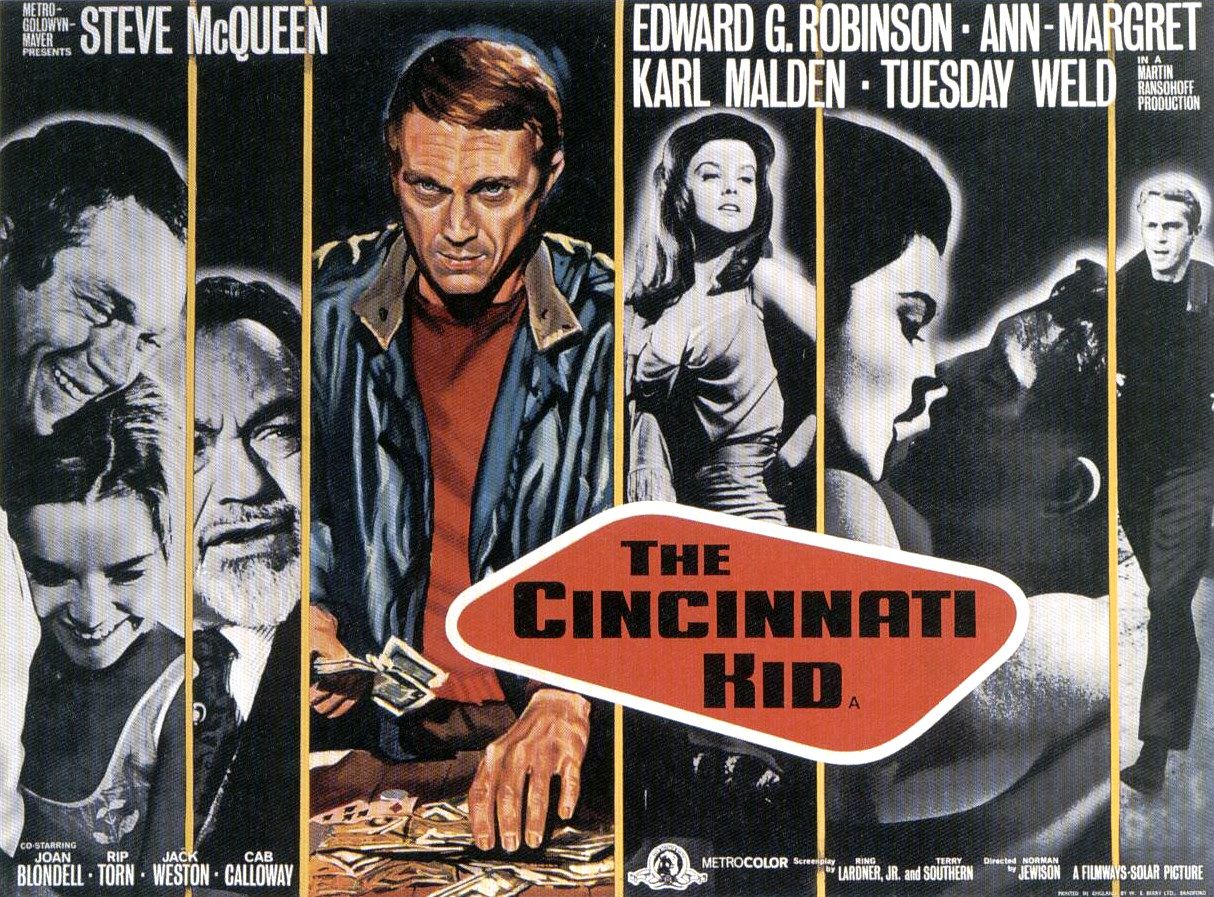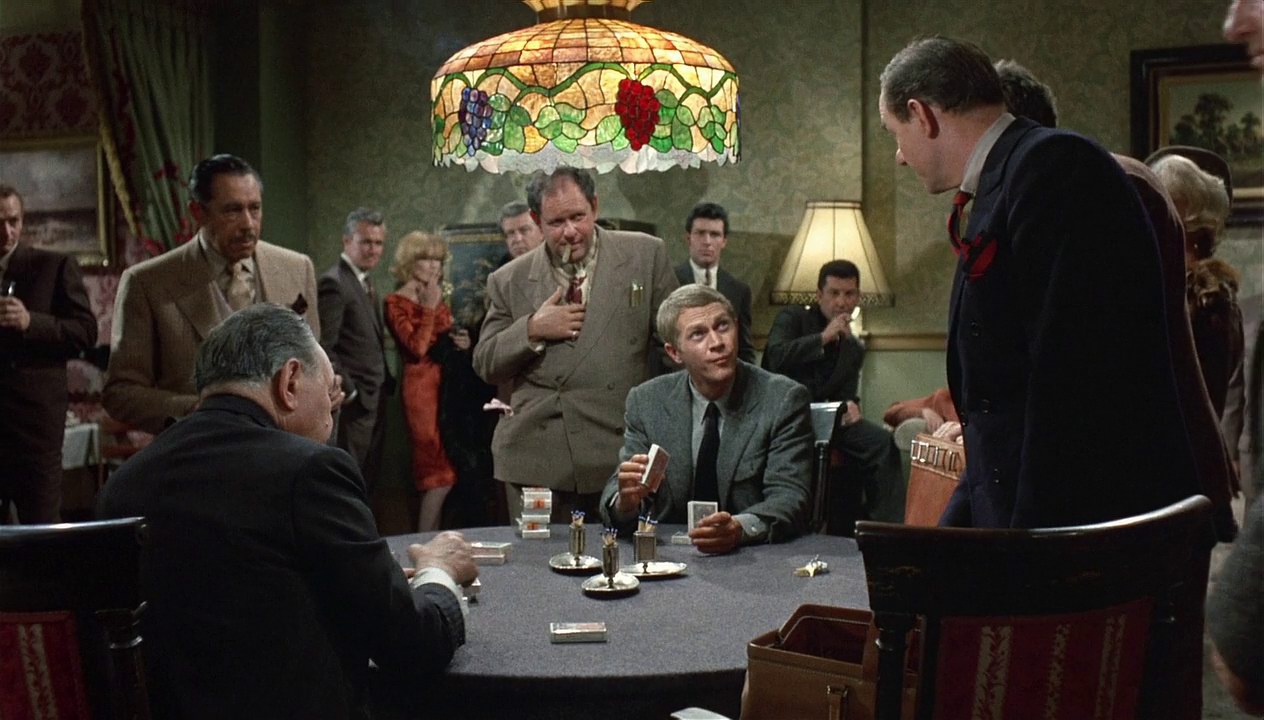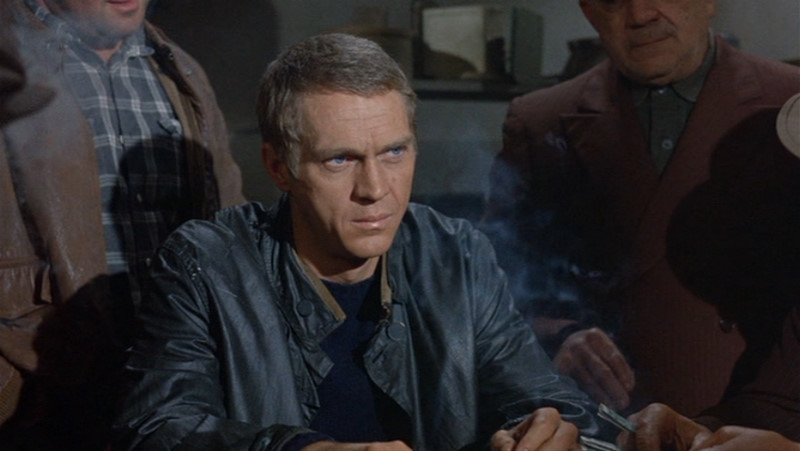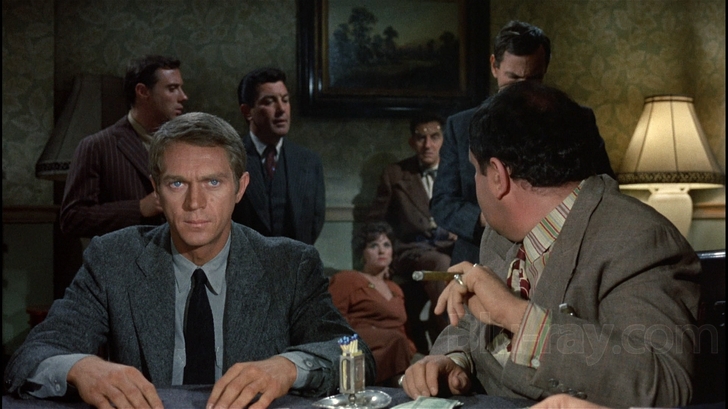1 Aug
Four years after the massive critical success of The Hustler in 1961, Norman Jewison – director of the excellent In The Heat of the Night and the popular original of The Thomas Crown Affair – went to work on a movie adaptation of the similarly plotted of Richard Jessup pulp classic: The Cincinnati Kid.
The Cincinnati Kid transfers the action. Where The Hustler dealt with pool halls, this time the baize is spread across a card – rather than pool – table. Times had moved on a little, and now the cinematography was in glorious technicolor, a look that doesn’t fit quite as well with the gloomy world of small time crooks, conmen, and card sharps. A rather too wrinkled Steve McQueen stepped in as the glory hunting hustler ‘The Kid’, and Edward G Robinson plays Lancey Howard ‘The Man’.

Who is this Kid Anyways
The story is a meandering look at the relationships and world of Eric ‘The Kid’ Stoner in the run up to a big money game against Lancey ‘The Man’ Howard, a big time gambler, and the man to beat. The Kid is looking for glory, while the people around him hunt for something else.
The script was adapted from Jessup’s novel by screenwriters Ring Lardner Jr and Terry Southern, who, between them, have a couple of classic movies with similarly oblique and rambling plots: Dr Strangelove, M*A*S*H, and Easy Rider. And there is a kind of delicacy to the way the plotting is handled, a lot of what goes on in the story has more to do with the characters than it does with real change.
We are introduced to Ann-Margret’s character as she cuts a puzzle piece to fit, the first of many invasions into the ‘hunt for glory’ plot which makes the unspoken implications of the final hand so controversial. Details like this abound.
We quickly find that she has eyes for The Kid despite her marriage to Shooter, the Kid’s mentor, and despite her friendship with Christian (an allegorical name for the innocent non-gambler in the plot) the Kid’s beau. This pair of romantic triangles is mirrored with another pair of deals to cheat. The Kid trying to keep Shooter from rigging the game on his behalf, while the wealthy Slade tries to force Shooter as part of his revenge on Lancey. The Man has his own plan in place to beat the kid with Lady Fingers, a set up that exists entirely off screen.
As the Kid scrambles through the ethical mire of 1930s New Orleans and keep himself from getting his fingers broken before he can get in the big game with Lancey Howard, we get to see the world he inhabits. Cock fighting and small time games with pinstriped gangsters, tossing nickels with a shoe shine boy, and in the background the jazz sax riffs of Lalo Schffrin the man behind the Mission Impossible theme music.
From out of the shadow of The Hustler
Having re-watched both The Hustler and The Cincinatti Kid in quick succession in order to write these reviews, the comparisons between the two films are striking; and the short version is that in a head to head race The Hustler just flat out wins as a movie. Robert Rossen’s adaptation of Walter Tevis’s novel still sets the standard for sports and gambling movies.
The fact that McQueen and the star of The Hustler, Paul Newman, are already linked somewhat as big Hollywood rivals by the now notorious poster negotiations for The Towering Inferno makes the films seem even more entrenched in competition. The poster story involved a bizarre conflict over where the names of the actors were to be placed on the publicity materials. Both stars wanted to be higher up and to the left of the other: the privileged place for the leading star. The resolution was to have one to the left but lower and the other to the right but higher. An elegant compromise.
But film does need to stand on its own, and with the caveat noted that I found it hard not to sit there drawing comparisons, I’ll do my best not to bring up The Hustler again.

A Very Not Bad Film
So, on its own terms, The Cincinatti Kid is pretty good. It’s fairly straightforward set-up belies a solid character driven script which cheerfully deviates from what seems to be the plotted path to take us on a sort of whistle stop tour of New Orleans gambling.
The characterisation is one of its two strongest traits. The performances from Ann-Margret and Edward G Robinson are both great. The former playing up her sex symbol status as a contrast to Tuesday Weld’s babe in the woods. And when Joan Blondell storms in on a whirlwind made up of cheery banter, she shines in the room full of sour and calculating gamblers. Wholly ignoring my earlier intention, none of the characters in The Kid have half the weight of those in The Hustler. One does find it hard to avoid drawing a comparison between the rather light female roles in this movie, as compared to the magnificently written character of Sarah Packer in The Hustler. But I said I wouldn’t do that, and the roles are pretty solidly written for what they are.
The other best trait of the film is atmosphere it creates. 1930s New Orleans is sold pretty seamlessly as a vibrant world full of real-ish people. There are endless little details that make the wider world of the gamblers and of their city feel real and populated. Little bits like the poker player who notes his losses and wins hand by hand in a little pocket book, or the man who cries when his fighting cock is killed, or the big brass band that wanders the streets. Jazz is omnipresent on the soundtrack.
There is perhaps something a little patronising in the way the Kid relates to a friendly shoeshine boy, who occasionally hustles him out of a dime or quarter. This is the south in the 1940s remember, there seems to be a sort of whitewashing of the racial politics there. But then again, that isn’t really what the film is about. Gritty realities like that would impinge on the fantasy world of the 20th Century Mississippi gamblers.
There is also an almost Shakespearean escape to the country half way through, which hammers home the innocence of the Kid’s moll, Christian (played as sickly sweet as you can bear by Tuesday Weld). The escape reminds us that outside of the world of sharks and sharps, there is a less dog eat dog reality where yokel farmers can laugh in awe of the Kid’s card tricks. Unlike the Shakespearean ‘middle-worlds’ however, the character’s do not return from it changed changed. Instead, their former selves are thrown into sharp relief and we are left ready for the series of betrayals, personal and professional, that go on the make up the film’s stylish denouement.

How’s the Poker?
Where the film really shines is in the poker scenes. The movie is something of a classic in poker circles, perhaps because there just really aren’t that many films so completely about poker until Rounders, except for Robert Altman’s California Split which is a better but far less fun film than either, eschewing as it does, the pulpy enjoyment of most gambling movies in favor of a bleaker sort of close look at a pair of degenerates.
In The Cincinatti Kid, the poker scenes have a 30s vibe: all illicit, jazzy, back-room, and hotel-room poker. A seedy world for sure, but one that has an old world romance about it. The cheats here are sort of mythical archetypes more like the old river-boat gamblers than Rounders’ Worm.
The movie does suffer from one or two of the classic poker movie problems: the endless string bets (“I’ll call your two thousand and raise you three more”), the use of cash instead of chips (still better than seeing dice chips used in a high stakes game I suppose), and the usual assumption that the best player wins in any given session. None of these are significant blights, and the last one is an important sacrifice of realism on the altar of drama.
Hand for hand, the movie is mostly smart and solid. The game is five card stud and most of the hands are pairs or two pairs, not implausible hands. Most of them.
Only the final hand tests the bounds of probability, and even that seems a sort of tacit suggestion of offstage events that make too much sense thematically and realistically to dismiss as mere fan theories. But to get into that will require some spoilers. Do skip this next section, if that sort of thing is a drag for you. I’ll see you at the end for a final round up.

The Last Hand
So the final hand, which you can watch in full bellow starting at 22:40, basically ends with twenty five grand and an IOU for five more from the kid in the pot, because this game is a true no limit game – none of this nancying about with table stakes here. The kid has two pair showing, aces over tens, and is sure he’s got his man. The Man on the other hand is showing four cards to a Q-high straight flush.
The Man flips over his hole card and to everyone’s shock it is the the Jack of Diamonds for the threatened straight flush. The Kid looks gutshot, everyone gasps, Lancey Howard has beat The Kid. The game is over.
Then The Kid, still horrified, turns over his hole card. It is the ace. A full house versus a straight flush looks ridiculous in Casino Royale because it would just never happen in hold’em. Here the odds are even longer, that combination being dealt out by itself is literally hundreds of billions to one. When you look at the betting it gets longer still, how Lancey Howard didn’t fold on third or fourth street against a visible pair… that stretches credulity a bit too far.
The coda to the film is the dual wisdom of Lancey’s comment that that’s ‘what it’s all about: doing the wrong thing at the wrong time,’ and that The Kid will always be second best as long as The Man is around. And that sort of works as a straight up, here’s-what-we’re-giving-you type ending. It certainly seems to be the ending the film is suggesting, but only on the surface.
Bear in mind that in the run up to this, Shooter, the Kid’s friend has been dismissed by The Kid for cheating on his behalf, dealing the kid kings to start against the Man. But the dealer he’s replaced with: Lady Fingers is every bit the cheat that Shooter is, and a cheat of Howard’s generation no less, with a long term friendship with The Man.
Add to this that the central theme of the film is cheating at and away from the card table. The Kid has fallen into bed with his best friend’s wife, a woman who cheats at solitaire. In doing so he has betrayed Christian and Shooter in one move. Shooter’s dismissal from the table is cheating related. Lady Fingers is so called because of her skill manipulating cards. This film is about cheating, so when the final hand comes up, I don’t think it is a wild fan theory to think maybe the lesson is that being the Man is something Howard protects with some extra-legal help.
It would also make sense of the filmmaker’s decision to show The Kid’s hand after we know he’s already been beat. There is no card he can turn over to beat the Man’s straight flush. If turning the card over doesn’t show something new, then turning it over is an anti climax and makes for a weird beat. It’s done with such precision as well. So the information we get from the card being flipped is not that the kid was beat, we know that. Turning the card over shows the audience that, the Kid wasn’t outplayed, he was robbed.
Final Thoughts
Overall, the film gets a recommendation from me. I enjoyed it and I think it has aged pretty well, and is watchable for both the poker initiated and the average punter. I don’t think it is the great poker classic that some do, nor is it the damp squib that it must have appeared to be so soon after The Hustler (more on that next time.)
What do you think? Let us know in the comments.
